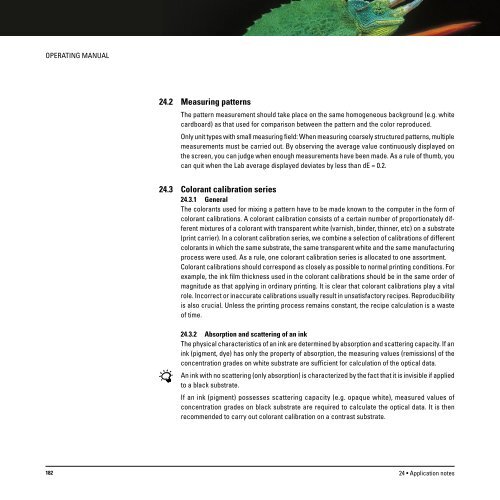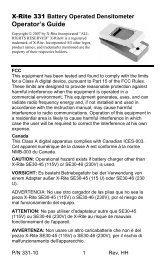Operating Manual
Operating Manual
Operating Manual
You also want an ePaper? Increase the reach of your titles
YUMPU automatically turns print PDFs into web optimized ePapers that Google loves.
OPERATING MANUAL<br />
24.2 Measuring patterns<br />
The pattern measurement should take place on the same homogeneous background (e.g. white<br />
cardboard) as that used for comparison between the pattern and the color reproduced.<br />
Only unit types with small measuring field: When measuring coarsely structured patterns, multiple<br />
measurements must be carried out. By observing the average value continuously displayed on<br />
the screen, you can judge when enough measurements have been made. As a rule of thumb, you<br />
can quit when the Lab average displayed deviates by less than dE = 0.2.<br />
24.3 Colorant calibration series<br />
24.3.1 General<br />
The colorants used for mixing a pattern have to be made known to the computer in the form of<br />
colorant calibrations. A colorant calibration consists of a certain number of proportionately different<br />
mixtures of a colorant with transparent white (varnish, binder, thinner, etc) on a substrate<br />
(print carrier). In a colorant calibration series, we combine a selection of calibrations of different<br />
colorants in which the same substrate, the same transparent white and the same manufacturing<br />
process were used. As a rule, one colorant calibration series is allocated to one assortment.<br />
Colorant calibrations should correspond as closely as possible to normal printing conditions. For<br />
example, the ink film thickness used in the colorant calibrations should be in the same order of<br />
magnitude as that applying in ordinary printing. It is clear that colorant calibrations play a vital<br />
role. Incorrect or inaccurate calibrations usually result in unsatisfactory recipes. Reproducibility<br />
is also crucial. Unless the printing process remains constant, the recipe calculation is a waste<br />
of time.<br />
24.3.2 Absorption and scattering of an ink<br />
The physical characteristics of an ink are determined by absorption and scattering capacity. If an<br />
ink (pigment, dye) has only the property of absorption, the measuring values (remissions) of the<br />
concentration grades on white substrate are sufficient for calculation of the optical data.<br />
An ink with no scattering (only absorption) is characterized by the fact that it is invisible if applied<br />
to a black substrate.<br />
If an ink (pigment) possesses scattering capacity (e.g. opaque white), measured values of<br />
concentration grades on black substrate are required to calculate the optical data. It is then<br />
recommended to carry out colorant calibration on a contrast substrate.<br />
182<br />
24 • Application notes












